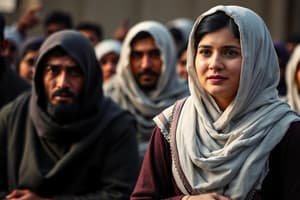Podcast
Questions and Answers
Considering the socio-political climate described in the text, which statement best encapsulates the complex role of Radio Mullah Fazlullah in the Swat Valley during Malala's early childhood?
Considering the socio-political climate described in the text, which statement best encapsulates the complex role of Radio Mullah Fazlullah in the Swat Valley during Malala's early childhood?
- Fazlullah emerged as a pivotal figure whose rhetoric, amplified by radio, instigated a gradual shift in societal values, challenging established educational paradigms and fostering an environment of fear and uncertainty. (correct)
- Fazlullah's influence was largely confined to the tribal belt, with minimal resonance in the Swat Valley due to the region's historical commitment to secular education and gender equality.
- Fazlullah's broadcasts served primarily as a religious counterpoint to secular governance, with limited direct impact on social norms beyond ritualistic adherence.
- Fazlullah's pronouncements were consistently interpreted as symbolic gestures of religious conservatism, devoid of practical implications for the daily lives of the Swat Valley's inhabitants.
Given the geopolitical context, which option most accurately describes the intricate relationship between the 9/11 attacks, the presence of Osama bin Laden in Afghanistan, and the subsequent rise of the Taliban's influence in Pakistan's Swat Valley?
Given the geopolitical context, which option most accurately describes the intricate relationship between the 9/11 attacks, the presence of Osama bin Laden in Afghanistan, and the subsequent rise of the Taliban's influence in Pakistan's Swat Valley?
- The 9/11 attacks were a localized incident with no significant ramifications for the broader regional dynamics of Afghanistan and Pakistan, and the Taliban's rise was purely coincidental.
- The 9/11 attacks triggered a chain of events that led to international intervention in Afghanistan, creating a power vacuum that facilitated the expansion of extremist factions, including the Taliban, into neighboring regions of Pakistan. (correct)
- The presence of Osama bin Laden in Afghanistan was largely a symbolic issue exploited by Western media, with minimal substantive impact on the Taliban's ability to operate and influence events in Pakistan.
- The United States' intervention in Afghanistan following 9/11 had the inadvertent effect of bolstering the Taliban's legitimacy within Pakistan, as they were perceived as a bulwark against foreign incursion.
Reflecting on Malala's dialogue with God, and her initial attempt to dismiss Fazlullah's influence within her school, which of the following options most accurately depicts the psychological coping mechanisms employed by children in conflict zones when confronted with encroaching extremism?
Reflecting on Malala's dialogue with God, and her initial attempt to dismiss Fazlullah's influence within her school, which of the following options most accurately depicts the psychological coping mechanisms employed by children in conflict zones when confronted with encroaching extremism?
- Children in conflict zones are largely immune to the psychological impact of extremism, as their cognitive development is not yet sophisticated enough to comprehend the gravity of the situation.
- Children often demonstrate resilience by compartmentalizing their fears, seeking normalcy through familiar social interactions, and attempting to exert agency in their immediate environment despite the pervasive threat of extremism. (correct)
- Children in conflict zones invariably exhibit uniform responses of fear and paralysis, with no capacity for nuanced coping strategies or resistance against extremist ideologies.
- Children universally embrace extremist ideologies as a means of self-preservation, internalizing the values and beliefs propagated by dominant factions to ensure their physical safety.
In the context of Malala's father's prescient warning—"Coming events cast their shadows before"—how does this proverb function as a critical commentary on the socio-political myopia exhibited by some of his contemporaries regarding the nascent threat of the Taliban?
In the context of Malala's father's prescient warning—"Coming events cast their shadows before"—how does this proverb function as a critical commentary on the socio-political myopia exhibited by some of his contemporaries regarding the nascent threat of the Taliban?
Considering Fazlullah's declaration that girls' schools were 'haram,' which epistemological framework best explains the rapid dissemination and acceptance of such pronouncements within the target community?
Considering Fazlullah's declaration that girls' schools were 'haram,' which epistemological framework best explains the rapid dissemination and acceptance of such pronouncements within the target community?
Given the historical context, which strategy is the most logical for combating the spread of misinformation and religious extremism in communities vulnerable to such influences, as exemplified by Fazlullah's rhetoric?
Given the historical context, which strategy is the most logical for combating the spread of misinformation and religious extremism in communities vulnerable to such influences, as exemplified by Fazlullah's rhetoric?
How might the psychological concept of 'learned helplessness' explain the gradual acceptance of Fazlullah's decrees within the Swat Valley community, particularly concerning the ban on girls' education?
How might the psychological concept of 'learned helplessness' explain the gradual acceptance of Fazlullah's decrees within the Swat Valley community, particularly concerning the ban on girls' education?
Considering the narrative's focus on the erosion of girls' educational opportunities, which strategy would most effectively promote gender equality and empower women in regions facing similar challenges?
Considering the narrative's focus on the erosion of girls' educational opportunities, which strategy would most effectively promote gender equality and empower women in regions facing similar challenges?
In what way does the narrative implicitly critique the international community's response to the rise of extremism in regions like the Swat Valley, particularly regarding the protection of human rights and the safeguarding of educational institutions?
In what way does the narrative implicitly critique the international community's response to the rise of extremism in regions like the Swat Valley, particularly regarding the protection of human rights and the safeguarding of educational institutions?
How can the systemic vulnerabilities exposed in 'I Am Malala,' regarding the spread of extremist ideologies and the suppression of education, inform contemporary strategies for countering similar threats in other regions experiencing socio-political instability?
How can the systemic vulnerabilities exposed in 'I Am Malala,' regarding the spread of extremist ideologies and the suppression of education, inform contemporary strategies for countering similar threats in other regions experiencing socio-political instability?
Flashcards
Radio Mullah
Radio Mullah
Refers to Fazlullah, a Taliban leader known for broadcasting extremist sermons.
9/11 Attacks
9/11 Attacks
A series of terrorist attacks on September 11, 2001, orchestrated by al-Qaeda.
Osama bin Laden
Osama bin Laden
Leader of al-Qaeda, known for masterminding the 9/11 attacks.
Fazlullah's Influence
Fazlullah's Influence
Signup and view all the flashcards
Taliban
Taliban
Signup and view all the flashcards
Haram
Haram
Signup and view all the flashcards
The Tribal Belt
The Tribal Belt
Signup and view all the flashcards
Proverb Quote
Proverb Quote
Signup and view all the flashcards
Girls' Education
Girls' Education
Signup and view all the flashcards
Ignoring Fazlullah Gossip
Ignoring Fazlullah Gossip
Signup and view all the flashcards
Study Notes
Malala's Childhood and the Taliban
- Malala was four years old when the 9/11 attacks occurred.
- In Afghanistan, the main topics of conversation were the Radio Mullah and the fighting across the border.
- Osama Bin Laden was a well-known figure.
- The Taliban were seen as a threat, but far away.
Fazlullah and the Taliban's Influence
- Fazlullah was a popular figure, associated with the Taliban.
- Fazlullah warned people that the Taliban would soon reach their valley.
- He stated that the Taliban were already in the tribal belt and were coming closer.
- He used a proverb: "Coming events cast their shadows before."
The Impact of the Taliban
- The Taliban declared school for girls haram.
- This declaration meant that girls' schools were forbidden.
- Fazlullah's words, delivered through the radio, had significant impact.
- This signified the beginning of the Taliban's campaign against girls' schools.
Studying That Suits You
Use AI to generate personalized quizzes and flashcards to suit your learning preferences.




